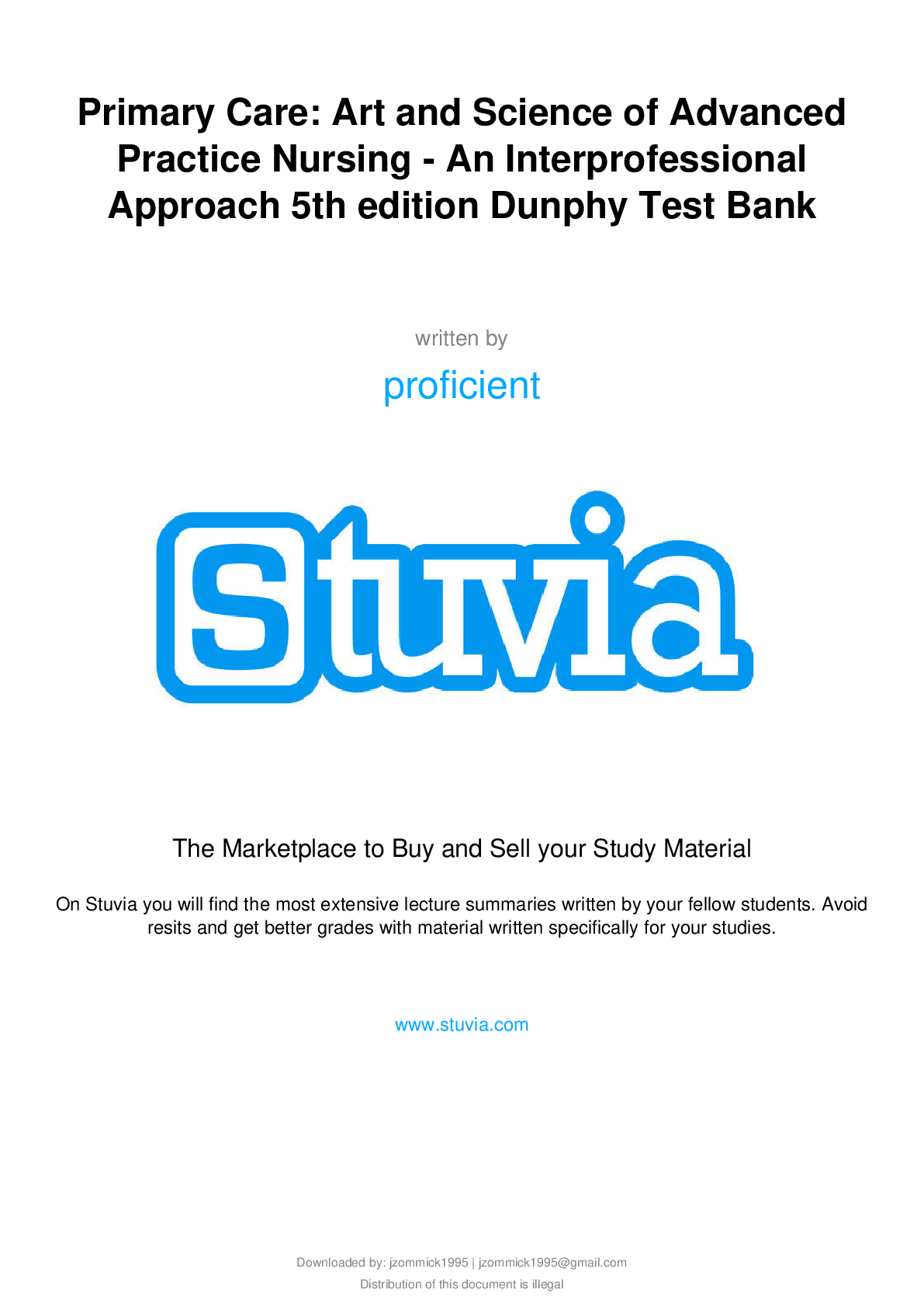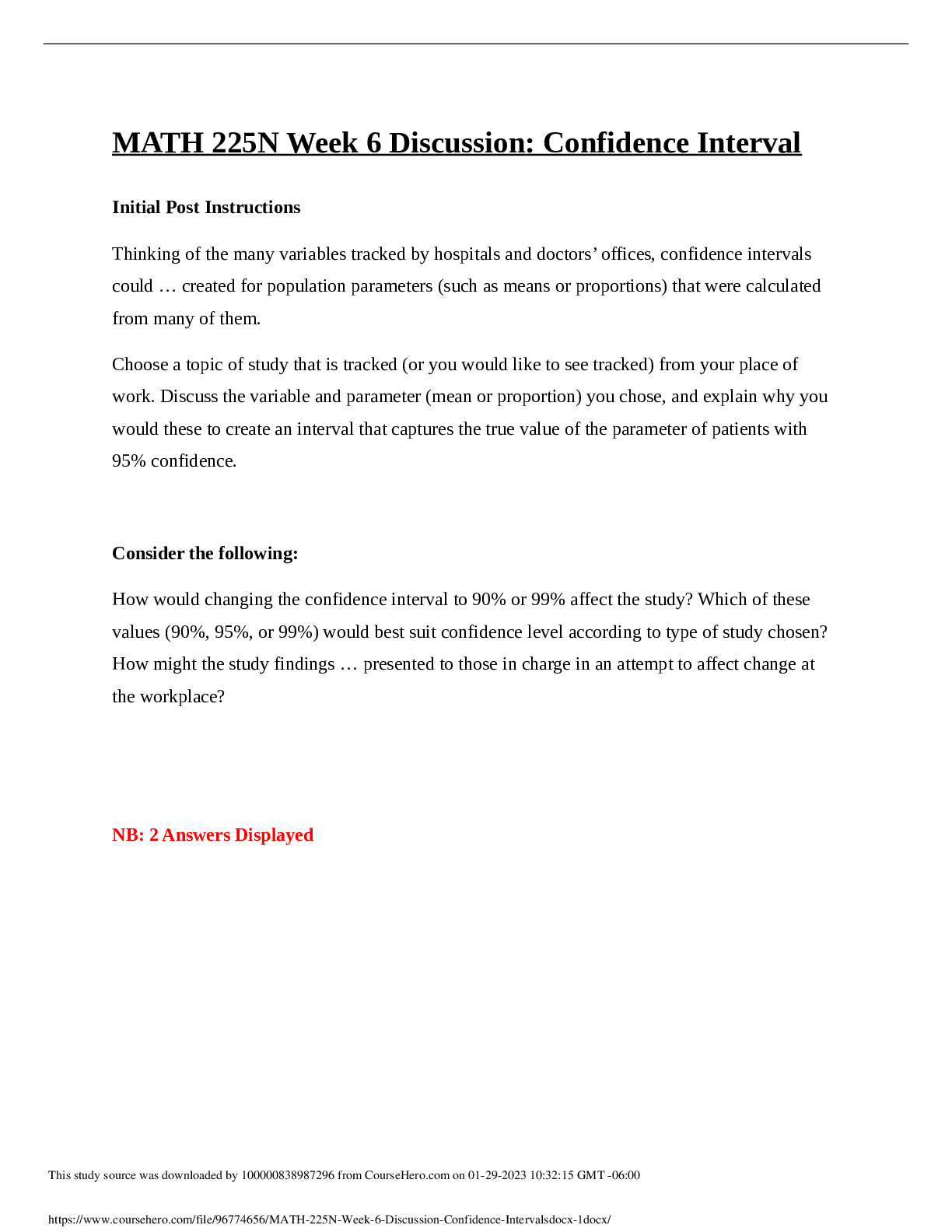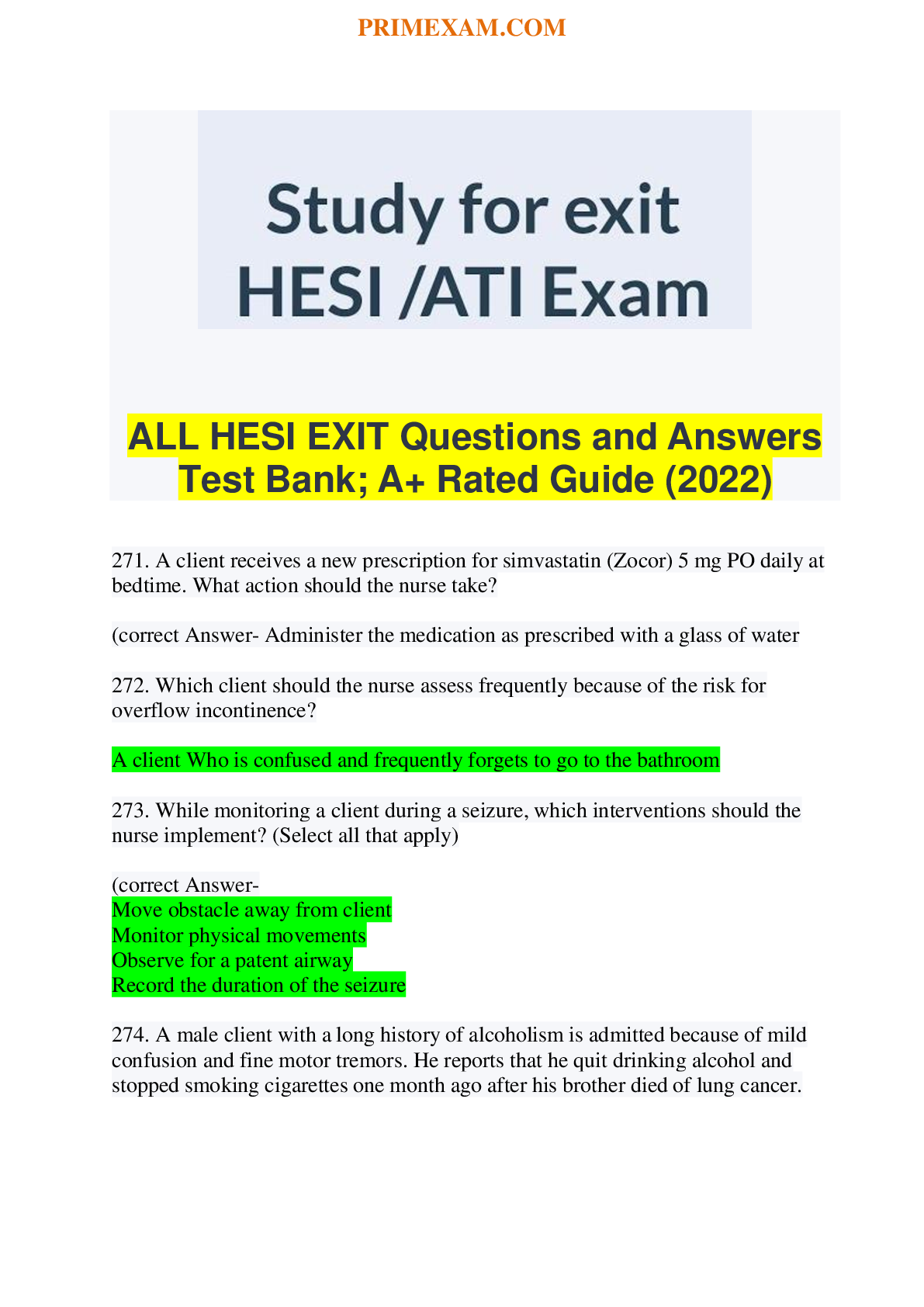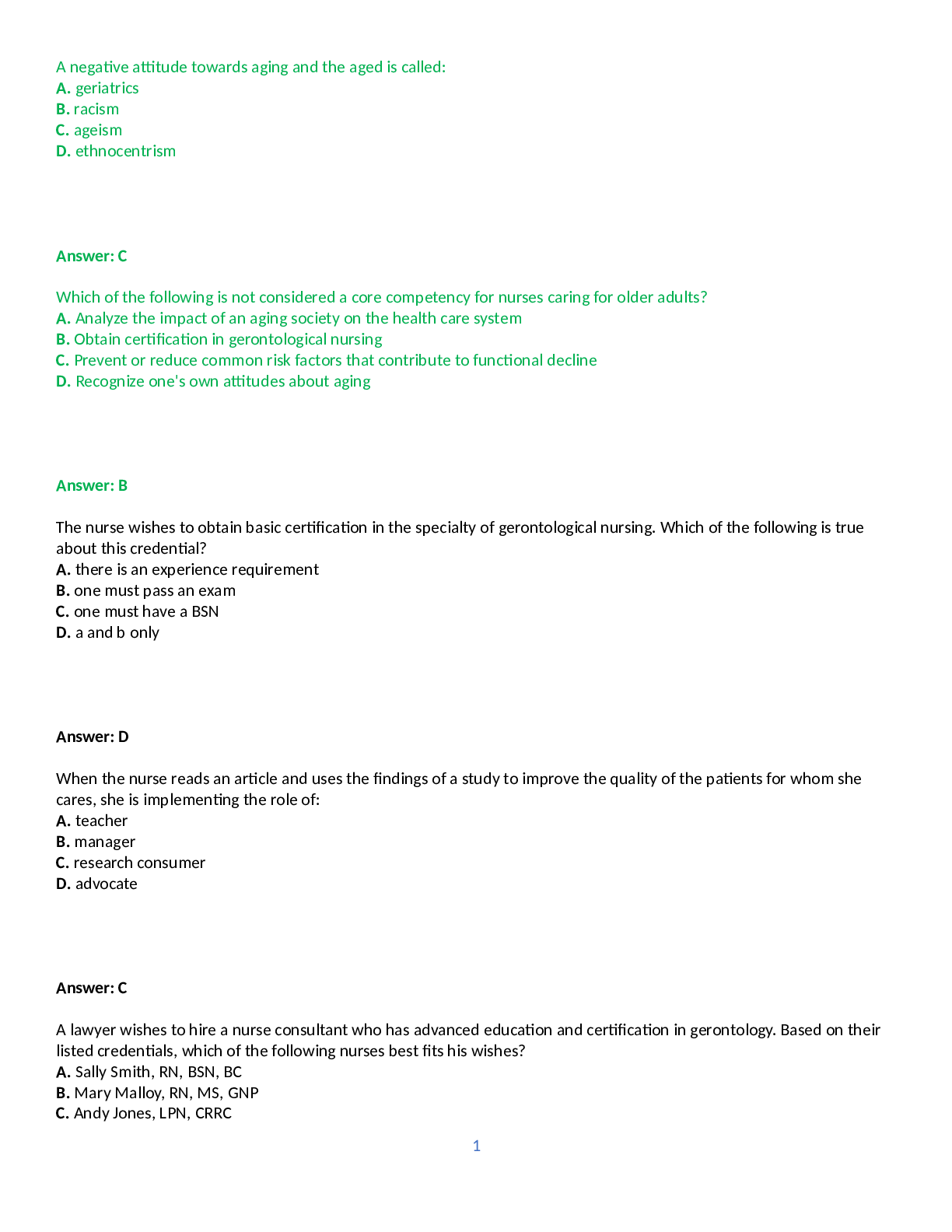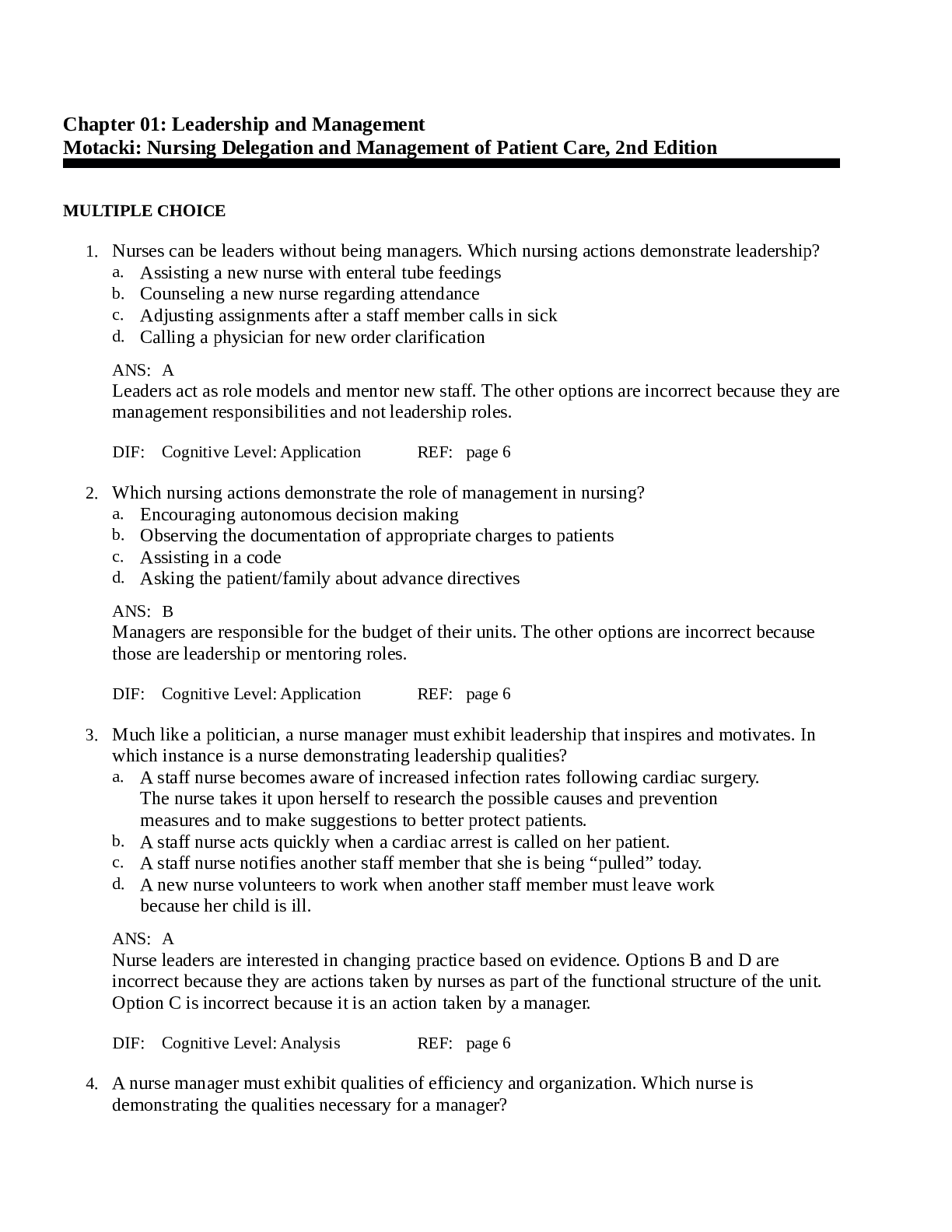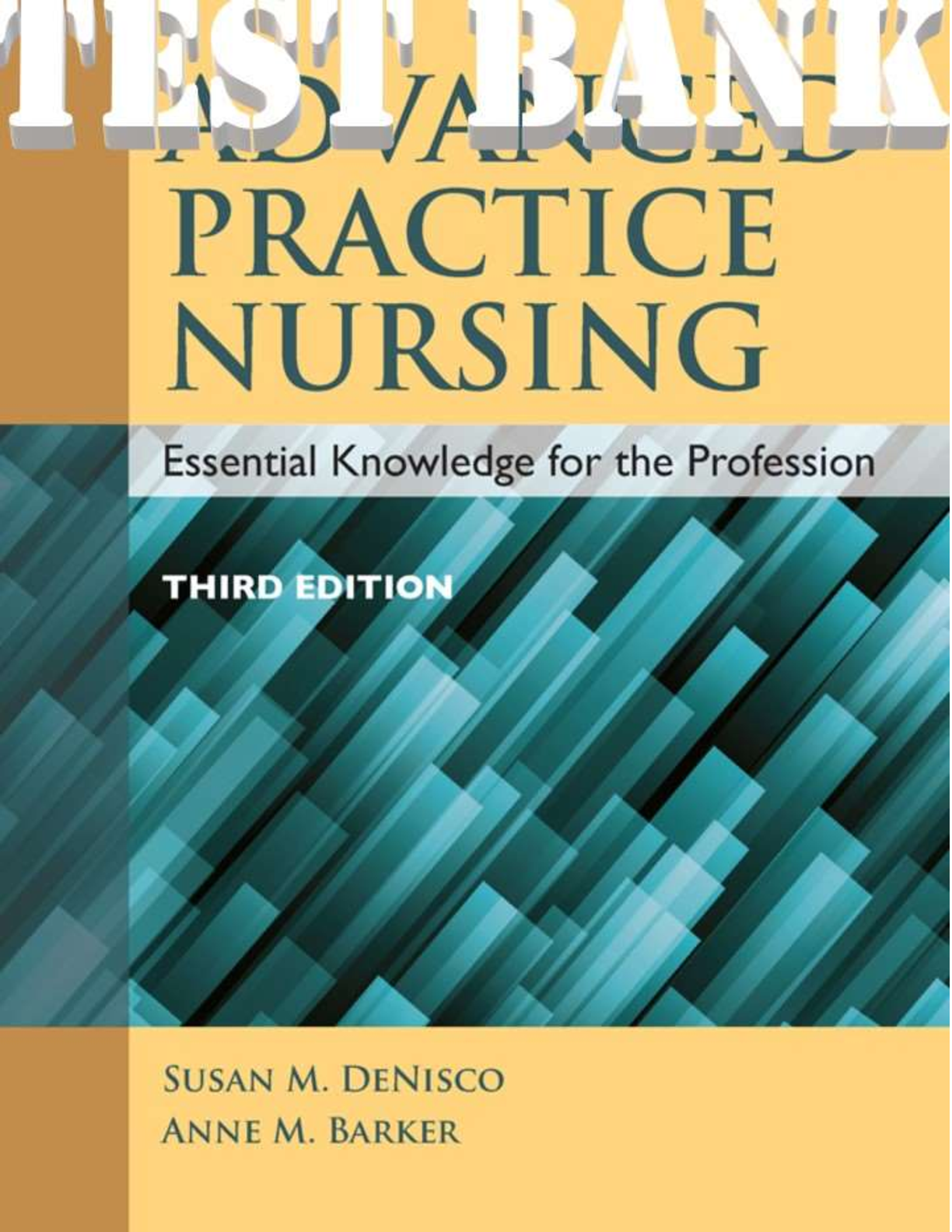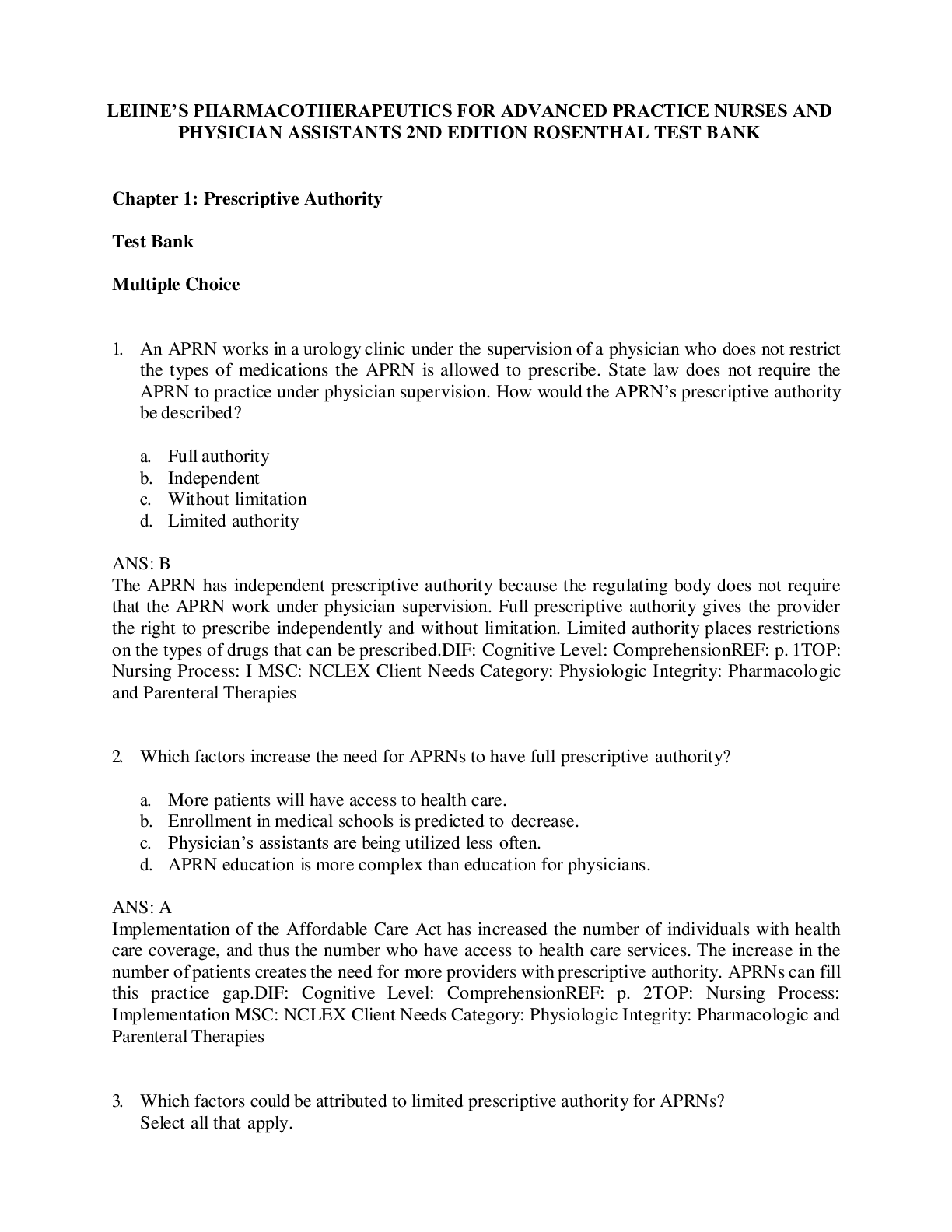*NURSING > TEST BANK > Rosenthal: Lehne's Pharmacotherapeutics for Advanced Practice Providers, 1st Ed' / Test Bank Lehne's (All)
Rosenthal: Lehne's Pharmacotherapeutics for Advanced Practice Providers, 1st Ed' / Test Bank Lehne's Pharmacotherapeutics for Advanced Practice Providers by Laura Rosenthal (completed all chapters A+ guide) 2023
Document Content and Description Below
25 b. determine whether a patient is a rapid or slow metabolizer of the drug. c. identify racial characteristics that affect psychosocial variation in drug response. d. produce a drug that is tailo... red to an individual patient’s genetic makeup. ANS: B Pharmacogenomics is the study of the ways genetic variations affect individual responses to drugs through alterations in genes that code for drug-metabolizing enzymes and drug receptors. For some drugs, the FDA requires genetic testing, and for others, this testing is recommended but not required. Genetic testing does not determine a drug’s therapeutic index; this is a measure of a drug’s safety based on statistics of the drug’s use in the general population (see Chapter 5). Any distinct physiologic differences in drug response among various racial populations are related to genetic differences and do not affect psychosocial differences in drug responses. Genetic testing is recommended to identify how a patient will respond to a drug and not to design a drug specific to an individual.DIF: Cognitive Level: AnalysisREF: pp. 53-54TOP: Nursing Process: Assessment MSC: NCLEX Client Needs Category: Physiologic Integrity: Reduction of Risk Potential Rosenthal: Lehne's Pharmacotherapeutics for Advanced Practice Providers, 1 st Ed. Chapter 7: Drug Therapy During Pregnancy and Breast-Feeding Test Bank Multiple Choice 58. Which types of drugs taken by a pregnant patient are more likely to have effects on a fetus? a. Drugs that are highly polar b. Ionized drugs c. Lipid-soluble drugs d. Protein-bound drugs ANS: C Lipid-soluble drugs cross the placenta more readily. Drugs that are highly polar, ionized, or protein bound cross the placenta with difficulty.DIF: Cognitive Level: AnalysisREF: p. 58TOP: Nursing Process: Evaluation MSC: NCLEX Client Needs Category: Physiologic Integrity: Reduction of Risk Potential 59. A patient in her second trimester of pregnancy tells the nurse she is worried that a medication she took before knowing she was pregnant might have harmed the fetus. What will the nurse do? a. Ask the patient what she took and when she learned she was pregnant. b. Contact the patient’s provider to request an ultrasound. c. Counsel the patient to consider termination of the pregnancy. d. Suggest to the patient that she go to a high-risk pregnancy center.www.testbanktank.com 26 ANS: A When a pregnant patient is exposed to a known or potential teratogen, the first step is to find out when the drug was taken and when the pregnancy began to determine whether the drug was taken during the period of organogenesis, when the fetus is most vulnerable to teratogenic effects. If exposure occurred during this phase, the provider may order an ultrasound. Counseling the patient to terminate a pregnancy is not a nursing role. Until more is known about this patient’s fetus, it is not necessary to refer her to another pregnancy center.DIF: Cognitive Level: ApplicationREF: p. 58TOP: Nursing Process: Evaluation MSC: NCLEX Client Needs Category: Physiologic Integrity: Physiologic Adaptation 60. A patient who has just learned she is pregnant has stopped using a prescription medication that she takes for asthma because she does not want to harm her baby. What will the nurse tell her? a. That asthma medications will not affect the fetus b. That her baby’s health is dependent on hers c. To avoid taking medications during her pregnancy d. To resume the medication in her second trimester ANS: B Asthmatic women who fail to take medication have a doubled risk of stillbirth; therefore, the nurse should encourage the patient to use her medications. Because the health of the fetus depends on the health of the mother, all drugs must be considered in light of the benefits of treatment versus the risks to the fetus. Asthma medications may have effects on the fetus, but the risk of stillbirth presents a greater risk. In this case, the patient needs to take the medication to treat her asthma and not wait until the second trimester.DIF: Cognitive Level: ApplicationREF: p. 61TOP: Nursing Process: Implementation MSC: NCLEX Client Needs Category: Physiologic Integrity: Physiologic Adaptation 61. A pregnant patient in active labor is admitted to the emergency department. A toxicology screen and a physical assessment reveal that the patient is an active heroin addict. The nurse who cares for the neonate after delivery should anticipate which clinical manifestations? a. Passivity and flat affect b. Diarrhea and salivation c. A shrill cry and irritability d. Restless sleep and seizures ANS: C The newborn of an active heroin addict experiences a withdrawal syndrome that includes shrill crying, vomiting, and extreme irritability. The newborn will not experience passivity or a flat affect, diarrhea, or salivation, or continuous restless sleep as a result of being born to an active heroin addict.DIF: Cognitive Level: ApplicationREF: p. 58TOP: Nursing Process: Assessment MSC: NCLEX Client Needs Category: Physiologic Integrity: Reduction of Risk Potentialwww.testbanktank.com 27 62. A pregnant patient asks the nurse about the safe use of medications during the third trimester. What will the nurse tell her about drugs taken at this stage? a. They may need to be given in higher doses if they undergo renal clearance. b. They require lower doses if they are metabolized by the liver. c. They are less likely to cross the placenta and affect the fetus. d. They are more likely to cause anatomical defects if they are teratogenic. ANS: A In the third trimester, drugs excreted by the kidneys may have to be increased, because renal blood flow is doubled, the glomerular filtration rate is increased, and drug clearance is accelerated. Hepatic metabolism increases, meaning that drugs metabolized by the liver must be increased. All drugs can cross the placenta. Anatomic defects are more likely to occur in the embryonic period, which is in weeks 3 through 8 in the first trimester.DIF: Cognitive Level: AnalysisREF: p. 60TOP: Nursing Process: Evaluation MSC: NCLEX Client Needs Category: Physiologic Integrity: Reduction of Risk Potential 63. A patient has just given birth to a baby boy with a cleft palate. The nurse will review the patient’s medication history with special emphasis on drugs taken during which period? a. Before she became pregnant b. During the first trimester c. During the second trimester d. During the third trimester ANS: B Gross malformations typically are the result of teratogens consumed during the first trimester. Using teratogenic drugs before becoming pregnant is a risk because 50% of pregnancies are unintended, and a patient could become pregnant while taking the drug. Exposure to teratogens during the second or third trimester usually alters function, not gross anatomy.DIF: Cognitive Level: ApplicationREF: p. 58TOP: Nursing Process: Implementation MSC: NCLEX Client Needs Category: Physiologic Integrity: Physiologic Adaptation 64. A nurse is caring for a patient and her newborn immediately after delivery. The patient’s medication history includes prenatal vitamins throughout pregnancy, one or two glasses of wine before knowing she was pregnant, occasional use of an albuterol inhaler in her last trimester, and intravenous morphine during labor. What will the nurse expect to do? a. Administer opioids to the infant to prevent withdrawal syndrome. b. Monitor the infant’s respirations and prepare to administer naloxone if needed. c. Note a high-pitched cry and irritability in the infant and observe for seizures. d. Prepare the patient for motor delays in the infant caused by the alcohol use.www.testbanktank.com 28 ANS: B Narcotics given for pain during labor cross the placenta and can cause respiratory depression in the infant. Nurses must be prepared to provide respiratory support and to give naloxone to reverse the narcotic effects if necessary. Exposure to opioids during labor is not sufficient to cause dependence, so withdrawal syndrome is not an issue. Infants withdrawing from drugs have a high- pitched cry and are irritable, which is not expected in this case. Any drug taken during the first weeks of pregnancy tends to have an “all or none” effect, meaning that it either causes death of the conceptus or, if sublethal, the conceptus recovers.DIF: Cognitive Level: ApplicationREF: p. 58TOP: Nursing Process: Implementation MSC: NCLEX Client Needs Category: Physiologic Integrity: Physiologic Adaptation 65. A woman who is breastfeeding her infant must take a prescription medication for 2 weeks. The medication is safe, but the patient wants to make sure her baby receives as little of the drug as possible. What will the nurse tell the patient to do? a. Give the baby formula as long as the mother is taking the medication b. Take the medication immediately after breastfeeding c. Pump breast milk and feed the baby by bottle d. Take the medication 1 hour before breastfeeding ANS: B Taking the medication immediately after breastfeeding minimizes the drug concentration in the breast milk at the next feeding. Disrupting breastfeeding is not indicated. Pumping the breast milk will not diminish the drugs or drug concentration in the breast milk. Taking the medication 1 hour before breastfeeding will increase concentrations of the drug in the breast milk.DIF: Cognitive Level: ApplicationREF: p. 63TOP: Nursing Process: Implementation MSC: NCLEX Client Needs Category: Physiologic Integrity: Reduction of Risk Potential 66. A nursing student asks the nurse why more is not known about the teratogenic effects of maternal medication ingestion during pregnancy. Which response by the nurse is correct? a. “Clinical trials to assess this risk would put the fetus at risk.” b. “It is safer to recommend that pregnant women avoid medications while pregnant.” c. “Most women are reluctant to admit taking medications while they are pregnant.” d. “The relatively new MEPREP study will allow testing of medications during pregnancy in the future.” ANS: A One of the greatest challenges in identifying drug effects on a developing fetus has been the lack of clinical trials, which, by their nature, would put the developing fetus at risk. Many pregnant women need prescription medications and not taking those would put the fetus at risk by compromising the health of the mother. The MEPREP study is a retrospective study to learn about possible outcomes related to known maternal drug exposure.DIF: Cognitive Level: AnalysisREF:www.testbanktank.com 29 p. 57TOP: Nursing Process: Evaluation MSC: NCLEX Client Needs Category: Physiologic Integrity: Physiologic Adaptation 67. A nurse is teaching a class to a group of pregnant patients. The nurse correctly teaches that the highest risk of teratogen-induced gross malformations exists during which time? a. Immediately before conception b. During the first trimester c. During the second trimester d. During the third trimester ANS: B Gross malformations are caused by exposure to teratogens during the embryonic period, which is considered the first trimester. This is the time when the basic shape of internal organs and other structures is established. No risk exists immediately before conception unless the medication is a category X drug. Teratogen exposure during the second and third trimesters usually disrupts function rather than gross anatomy.DIF: Cognitive Level: ComprehensionREF: p. 61TOP: Nursing Process: Implementation MSC: NCLEX Client Needs Category: Physiologic Integrity: Reduction of Risk Potential Rosenthal: Lehne's Pharmacotherapeutics for Advanced Practice Providers, 1 st Ed. Chapter 8: Drug Therapy in Pediatric Patients Test Bank Multiple Choice 1. A nurse is caring for an infant after a surgical procedure. After ensuring that the ordered dose is appropriate for the infant’s age and weight, the nurse administers a narcotic analgesic intravenously. When assessing the infant 15 minutes later, the nurse notes respirations of 22 breaths/minute and a heart rate of 110 beats/minute. The infant is asleep in the parent’s arms and does not awaken when vital signs are assessed. The nurse understands that these findings are the result of: a. an allergic reaction to the medication. b. immaturity of the blood-brain barrier in the infant. c. toxic effects of the narcotic, requiring naloxone as an antidote. d. unexpected side effects of medications in infants. ANS: B The blood-brain barrier is not as well developed in infants, making them more susceptible to CNS effects of medications. This assessment of the patient reveals no signs of an allergic reaction. Although this infant is somnolent, the vital signs are stable, so toxicity is not a concern. CNSwww.testbanktank.com 30 effects are not unexpected with narcotic analgesics, but they may be more pronounced in infants.DIF: Cognitive Level: ApplicationREF: p. 65TOP: Nursing Process: Evaluation MSC: NCLEX Client Needs Category: Physiologic Integrity: Pharmacologic and Parenteral Therapies 2. A child will receive 750 mg of an antibiotic for 10 days. The child attends day care. The drug may be dosed in several ways and is available in two concentrations. Which dosing regimen will the nurse discuss with the child’s provider? a. 250 mg/5 mL to 375 mg PO twice daily b. 250 mg/5 mL to 250 mg PO three times daily c. 500 mg/5 mL to 250 mg PO three times daily d. 500 mg/5 mL to 375 mg PO twice daily ANS: D To promote adherence to a drug regimen in children, it is important to consider the size and timing of the dose. In this case the preparation containing 500 mg/5 mL means that a smaller volume can be given, which is more palatable to a child. Twice daily dosing is more convenient for parents, especially when a child is in day care or school; it also helps prevent the problem of the medication being left either at home or at school.DIF: Cognitive Level: ApplicationREF: p. 68TOP: Nursing Process: Implementation MSC: NCLEX Client Needs Category: Physiologic Integrity: Reduction of Risk Potential 3. Parents ask the nurse why an over-the-counter cough suppressant with sedative side effects is not recommended for infants. Which response by the nurse is correct? a. “Babies have a more rapid gastric emptying time and do not absorb drugs well.” b. “Cough medicine tastes bad, and infants usually won’t take it.” c. “Infants are more susceptible to central nervous system effects than are adults.” d. “Infants metabolize drugs too rapidly, so drugs are not as effective.” ANS: C Drugs cross the blood-brain barrier more readily in infants, making these patients more susceptible to central nervous system (CNS) side effects. Infants have a prolonged and irregular gastric emptying time and absorb drugs in the stomach more quickly. Although it may be true that cough medicines taste bad and are difficult to administer, this is not a contraindication to giving them. Infants metabolize drugs more slowly.DIF: Cognitive Level: AnalysisREF: p. 66TOP: Nursing Process: Implementation MSC: NCLEX Client Needs Category: Physiologic Integrity: Reduction of Risk Potential 4. A nurse caring for a 5-year-old child notes that the child has discoloration of several teeth. When taking a medication history, the nurse will ask about which group of medications? a. Glucocorticoidswww.testbanktank.com 31 b. Salicylates c. Sulfonamides d. Tetracyclines ANS: D Tetracyclines cause discoloration in developing teeth in children. Glucocorticoids are associated with growth suppression. Salicylates are associated with Reye syndrome. Sulfonamides are associated with kernicterus in newborns.DIF: Cognitive Level: ApplicationREF: p. 67TOP: Nursing Process: Evaluation MSC: NCLEX Client Needs Category: Physiologic Integrity: Reduction of Risk Potential 5. An infant has allergies and often develops a pruritic rash when exposed to allergens. The infant’s parents ask the nurse about using a topical antihistamine. What should the nurse tell them? a. Antihistamines given by this route are not absorbed as well in children. b. Applying an antihistamine to the skin can cause toxicity in this age group. c. The child will also need oral medication to achieve effective results. d. Topical medications have fewer side effects than those given by other routes. ANS: B Drug absorption through the skin is more rapid in infants, because their skin is thinner and has greater blood flow; therefore, infants are at increased risk of toxicity from topical drugs. Because of increased drug absorption through the skin, infants should not be given additional drugs via other routes. If a drug is more likely to be absorbed rapidly, it will have more side effects.DIF: Cognitive Level: ApplicationREF: p. 66TOP: Nursing Process: Planning MSC: NCLEX Client Needs Category: Physiologic Integrity: Reduction of Risk Potential 6. An infant is receiving a medication that has a narrow therapeutic range. The nurse reviews the medication information and learns that the drug is excreted by the kidneys. When giving the medication, the nurse will assess the infant for: a. decreased effectiveness of the drug. b. shorter period of the drug’s effects. c. signs of drug toxicity. d. unusual CNS effects. ANS: C Renal drug excretion is lower in infants, so drugs that are eliminated primarily by renal excretion should be given in reduced doses or at longer intervals. Drugs with a narrow therapeutic range should be monitored closely for toxicity. This drug likely will have intensified effects and be present for a longer time. Nothing indicates that unusual CNS effects will occur because of this alteration in excretion.DIF: Cognitive Level: ApplicationREF: p. 66TOP: Nursing Process:www.testbanktank.com 32 Evaluation MSC: NCLEX Client Needs Category: Physiologic Integrity: Reduction of Risk Potential 7. A pediatric nurse is teaching nursing students to calculate medication doses for children using a formula based on body surface area. Which statement by a nursing student indicates understanding of the teaching? a. “This formula helps approximate the first dose; other doses should be based on clinical observations.” b. “This formula accounts for pharmacokinetic factors that are different in children.” c. “Using this formula will prevent side effects of medications in children.” d. “This formula can determine medication dosing for a child of any age.” ANS: A This formula helps determine an approximate first dose for a child that is extrapolated from an adult dose; subsequent doses should be adjusted based on clinical outcome and serum plasma levels. The formula accounts only for differences in weight and not for differences in pharmacokinetic factors. The formula helps determine an effective dose but cannot account for unusual side effects that may occur in children. It may not be effective for all ages because of rapid changes in pharmacokinetics.DIF: Cognitive Level: ComprehensionREF: p. 67TOP: Nursing Process: Assessment MSC: NCLEX Client Needs Category: Physiologic Integrity: Reduction of Risk Potential 8. A pediatric nurse is teaching nursing students about medication administration in children. Which statement by a student indicates an understanding of the teaching? a. “Drugs effective in adults may not work in children, even if the dose is proportional for weight and size.” b. “Infants metabolize drugs more quickly than do older children and adults.” c. “Side effects of drugs in children are similar to side effects of drugs in adults.” d. “The known differences in drug effects in children versus those in adults are related to the size of the patient.” ANS: A Drugs have different effects in children for many reasons besides simply the amount of drug per unit of weight. Because two-thirds of drugs used in children have never been tested in children, most of our knowledge of their effects is anecdotal and requires research. Infants metabolize drugs more slowly because of immaturity of organ systems that metabolize drugs. Because of differences in metabolism, absorption, and excretion of drugs in infants and children, side effects of drugs also differ. Again, the differences in drug effects are related to many factors, not just size and relative dose.DIF: Cognitive Level: ApplicationREF: p. 65TOP: Nursing Process: Diagnosis MSC: NCLEX Client Needs Category: Physiologic Integrity: Reduction of Risk Potentialwww.testbanktank.com 33 9. A nurse is teaching nursing students about pediatric [Show More]
Last updated: 1 year ago
Preview 1 out of 86 pages
Instant download

Buy this document to get the full access instantly
Instant Download Access after purchase
Add to cartInstant download
Reviews( 0 )
Document information
Connected school, study & course
About the document
Uploaded On
Jan 29, 2023
Number of pages
86
Written in
Additional information
This document has been written for:
Uploaded
Jan 29, 2023
Downloads
0
Views
50

